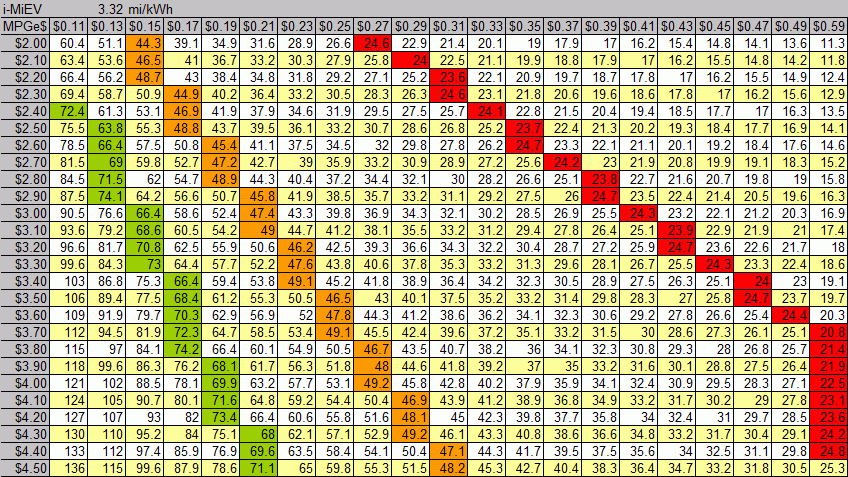I established true out of pocket cost MPGe using actual measured data early in my blog. After all, the amount of money I pay compared to gas car is what matters to me, and probably to most people as well.
I used to think that everyone knew this, but apparently, most people were (are?) oblivious to it; they believe they're getting 100+ MPGe, because EPA tells them so. While that's true with regard to energy consumption, that's not what most people are expecting. When they hear MPG, they think of the money they'll spend / save. Telling people that EV gets 124 MPGe is committing fraud without telling them that MPGe doesn't have much to do with money.
In this post, I present various tables that show out of cost MPGe (MPGe$) for various cars. For SparkEV, I was able to measure the actual mi/kWh, and have an accurate table in link above. But for other cars, I have to infer mi/kWh from EPA's MPGe figure.
First, these are EPA MPGe converted to mi/kWh using
mi/kWh = MPGe / 33.7kWh/gal
Note that mi/kWh inferred from EPA is about 20% lower for SparkEV compared to actual measured mi/kWh. Therefore, it could be that other cars also have higher mi/kWh when actually measured. In any case, the table should give you an idea of MPGe$, which you can boast (or feel shamed) when speaking with gas car drivers for apples-to-apples comparison.
To read the table, rows are $/gal at local gas station and columns are $/kWh you pay to charge the car. For example, $2.60/gal gas in SoCal on Oct 2015 and $0.33/kWh a household would pay for $150/mo electric bill would result in 29 MPGe$ for BMWi3, 20.8 MPGe$ for Tesla P90D. Those are far away from EPA's 124 MPGe and 89 MPGe for those cars.
Even the best case of $2.80/gal premium gas and $0.19/kWh for SDG&E base rate would result in 54.2MPGe$ for BMWi3, still far, far away from EPA's 124 MPGe. SoulEV with EPA 105 MPGe would only get 46 MPGe$, worse than Prius using premium fuel! But again, this is using EPA's "mystery meat" MPGe figure; actual could be bit better (10% to 20%?)
Last column of $0.59/kWh is what Blink charges for their DCFC if you're a member; you get less than 20MPGe$ in most cases. For those who pay $2/kWh (Leaf at 88% battery at DCFC, non OTG plan), you can take $0.25/kWh MPGe$ and divide by 8; with $2.60/gal, you'd be getting about 4MPGe$.
Green is 75 MPG boundary (2001 Honda Insight), orange is 50 MPG boundary (Toyota Prius), red is 25 MPG boundary (typical gas car).
Green is 75 MPG boundary (2001 Honda Insight), orange is 50 MPG boundary (Toyota Prius), red is 25 MPG boundary (typical gas car).
Money equivalent to liters per 100km for our Metric friends. Conversion factor used from MPGe$ to these values are 100/1.609344.
Because row and column units are the same, if you stick to same currency denomination, the math works out. For example, if it's BMW i3 with Euro 0.19/kWh and Euro 1.50/Liter, you would be paying equivalent to gas car that gets 2.14 L/100km.
Green is 3.14 L/100km boundary (2001 Honda Insight), orange is 4.7 L/100km boundary (Toyota Prius), red is 9.41 L/100km boundary (typical gas car in US).
Why is this color scheme seem different (prettier?) than MPGe$? It's done by comparing successive rows whereas MPGe$ color is done by comparing successive columns. This has to do with row resolution being less in L/100km tables to cover more range (about $2/gal to $12/gal).















No comments:
Post a Comment